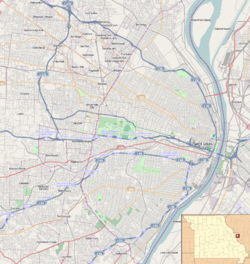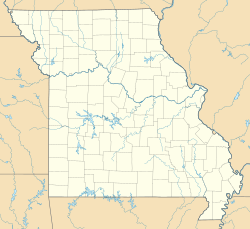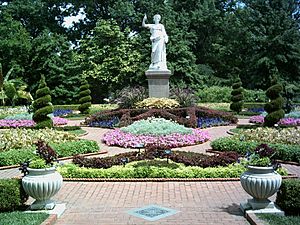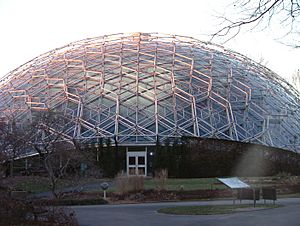Missouri Botanical Garden facts for kids
|
Missouri Botanical Garden
|
|
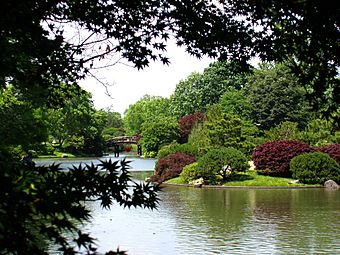
A view of Seiwa-en, the largest Japanese garden in North America
|
|
| Location | St. Louis, Missouri |
|---|---|
| Built | 1859 |
| Architect | Multiple |
| Architectural style | Late Victorian |
| NRHP reference No. | 71001065 |
Quick facts for kids Significant dates |
|
| Added to NRHP | November 19, 1971 |
| Designated NHLD | December 8, 1976 |
The Missouri Botanical Garden is a famous botanical garden in St. Louis, Missouri. People sometimes call it Shaw's Garden after its founder, Henry Shaw. He was a wealthy businessman who loved plants.
The garden has a huge collection of dried plant specimens called an herbarium. It has over 6.6 million specimens! This makes it the second largest in North America. Only the New York Botanical Garden has more.
Contents
History of the Missouri Botanical Garden
The land where the Missouri Botanical Garden now stands once belonged to Henry Shaw. He was a successful businessman. Records show that enslaved people worked on his land. In 2020, the garden shared some of their names. They included Peach, Juliette, Bridgette, Joseph, Jim, Sarah, Tabitha and her daughter Sarah, and Ester and her children.
The Missouri Botanical Garden opened in 1859. It is one of the oldest plant institutions in the United States. It is also a National Historic Landmark. This means it is a place of great historical importance. It is also listed on the National Register of Historic Places.
In 1983, the garden became part of the Metropolitan Zoological Park and Museum District. This district helps fund important cultural places in the St. Louis area.
The garden is a major center for plant research and science education. It is known around the world for its work. It is also a beautiful green space in the city. The garden covers 79 acres (about 32 hectares) of amazing plant displays.
It features a 14-acre (about 5.7 hectares) Japanese garden called Seiwa-en. This is a peaceful place for walking. The garden also has the Climatron, a special dome-shaped greenhouse. There is a children's garden with a pioneer village and a playground. You can also see Henry Shaw's original home from the 1850s. The garden is right next to Tower Grove Park, which was also created by Henry Shaw.
The garden often hosts special art exhibits. In 2006, it showed "Glass in the Garden" with glass sculptures by Dale Chihuly. Some of these pieces stayed at the garden. In 2008, sculptures by French artist Niki de Saint Phalle were displayed. In 2009, the garden celebrated its 150th birthday with a special floral clock.
After 40 years, Dr. Peter Raven retired as president in 2010. Dr. Peter Wyse Jackson took over as the new president.
Leaders of the Garden Over Time
- Henry Shaw (founder) until 1889
- William Trelease, director, 1889 to 1912
- George Thomas Moore, director, 1912 to 1953
- Edgar Anderson, director, 1954 to 1957
- Frits Warmolt Went, director, 1958 to 1963
- Peter H. Raven, director, 1971 to 2006; president and director, 2006 to 2010
- Peter Wyse Jackson, president, appointed 2010
Cultural Festivals at the Garden
The Missouri Botanical Garden hosts many fun cultural festivals each year. These include the Japanese Festival and the Chinese Culture Days. During these events, you can see beautiful plants from those cultures. There are also cultural arts, crafts, music, and food.
The Japanese Festival features exciting activities. You can watch sumo wrestling and taiko drumming. There are also koma-mawashi (top spinning) and kimono fashion shows. The garden is also famous for its bonsai collection. These are miniature trees grown in pots. You can see them all year, but they are a highlight during the Asian festivals.
Amazing Gardens and Features
The garden has many different areas to explore:
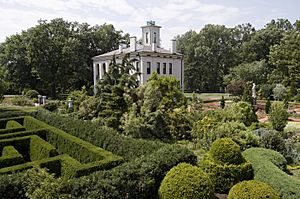
- Tower Grove House (1849) and Herb Garden – This was Henry Shaw's country home. It was designed in the Italianate style.
- Victory of Science over Ignorance – A marble statue from 1859.
- Linnean House (1882) – This is thought to be the oldest greenhouse west of the Mississippi River that has been open continuously. It used to be Shaw's orangery (a place for citrus trees). Now it mainly holds camellias.
- Gladney Rose Garden (1915) – A beautiful circular garden filled with roses and archways.
- Climatron (1960) and Reflecting Pools – The world's first geodesic dome greenhouse. It looks like a giant bubble! Inside, it's a lowland rainforest with about 1500 different plants.
- English Woodland Garden (1976) – This garden has plants like aconite, azaleas, bluebells, dogwoods, hosta, and trillium. They grow under the shade of tall trees.
- Seiwa-en Japanese Garden (1977) – This 14-acre (about 5.7 hectares) Japanese strolling garden is the largest in North America. It has lawns and paths around a 4-acre (about 1.6 hectares) central lake.
- Grigg Nanjing Friendship Chinese Garden (1995) – Designed by Yong Pan, this garden features gifts from Nanjing, China. It has a moon gate, a lotus gate, a pavilion, and special rocks from Lake Tai.
- Blanke Boxwood Garden (1996) – A beautiful walled garden with a collection of boxwood plants.
- Strassenfest German Garden (2000) – This garden shows plants native to Germany and Central Europe. It also has a statue of botanist George Engelmann.
- Biblical garden – This garden features plants mentioned in the Bible. You can see date palms, pomegranates, figs, olive trees, caper, mint, and citron.
- Ottoman garden – This garden has water features and plants that don't need much water (called xeriscape).
Butterfly House
The Missouri Botanical Garden also runs the Sophia M. Sachs Butterfly House. It is located in Chesterfield. The Butterfly House has a large indoor conservatory. It is 8000 square feet (about 743 square meters). Here, you can see many different kinds of butterflies flying freely. There is also an outdoor butterfly garden.
Earthways Center
The EarthWays Center is a special part of the Missouri Botanical Garden. It teaches people about "green" practices. This includes using renewable energy and saving energy. They help the public learn about how to live in a more sustainable way.
Shaw Nature Reserve
The Shaw Nature Reserve was started by the Missouri Botanical Garden in 1925. It was a place to keep plants safe from city pollution. The air in St. Louis later became cleaner. The reserve is still open to the public today. It is used for enjoyment, research, and education. The reserve is 2400 acres (about 9.7 square kilometers) large. It is located in Gray Summit, Missouri, about 35 miles (56 kilometers) from the city.
The Plant List Project
The Plant List is an online project. It was created by the Royal Botanic Gardens, Kew in England and the Missouri Botanical Garden. Its goal is to create a complete list of all known plant names. The Plant List has over 1 million scientific plant names. About 298,900 of these are accepted species names. It also lists 620 plant families and 16,167 plant groups (genera).
Living Earth Collaborative
In 2017, the Missouri Botanical Garden joined forces with the St. Louis Zoo and Washington University in St. Louis. They created a group called the Living Earth Collaborative. This group works to understand how humans can help protect natural environments. Their goal is to help plants, animals, and tiny living things (microbes) survive and thrive.
Sponsorship
Monsanto has given money to the Missouri Botanical Garden since the 1970s. They have donated $10 million. Because of this, the garden named its plant science building the 'Monsanto Center' in 1998.
Images for kids
-
Henry Shaw's mausoleum is located in the gardens.
See also
 In Spanish: Jardín botánico de Misuri para niños
In Spanish: Jardín botánico de Misuri para niños


